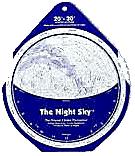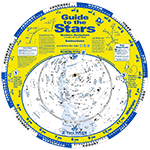|
1
|
Moon at perigee (closest to Earth) at 7h UT (365,983 km; angular size 32.7').
|
|
1
|
Moon near the Pleiades (40° from Sun, morning sky) at 12h UT.
• The Pleiades (Wikipedia)
|
|
2
|
Moon near Aldebaran (31° from Sun, morning sky) at 6h UT.
• Aldebaran (Wikipedia)
|
|
4
|
New Moon at 11:01 UT. Start of lunation 1157.
• Lunation Number (Wikipedia)
|
|
4
|
Earth at Aphelion (farthest from Sun) at 16h UT. The Sun- Earth distance is 1.016751 a.u. or about 152.1 million km.
• Earth at Aphelion (SpaceWeather.com)
• Photographic Size Comparison (Anthony Ayiomamitis)
|
|
5
|
Moon near Venus (8° from Sun) at 2h UT. Mag. -3.9.
• Venus (Wikipedia)
|
|
6
|
Moon near Beehive cluster (23° from Sun, evening sky) at 6h UT.
• Beehive Cluster (Wikipedia)
• M44: The Beehive Cluster (APOD)
|
|
7
|
Mercury at superior conjunction with the Sun at 3h UT. The elusive planet passes into the evening sky.
• Mercury (Wikipedia)
|
|
7
|
Moon near Regulus (evening sky) at 23h UT.
• Regulus (Wikipedia)
|
|
9
|
Moon very near Jupiter (61° from Sun, evening sky) at 10h UT. Mag. -1.8. Occultation visible from southern Africa and Antarctica.
• Jupiter (Wikipedia)
|
|
12
|
First Quarter Moon at 0:52 UT.
|
|
12
|
Moon near Spica (evening sky) at 8h UT.
• Spica (Wikipedia)
|
|
13
|
Moon at apogee (farthest from Earth) at 6h UT (distance 404,269 km; angular size 29.6').
|
|
14
|
Moon near Mars (evening sky) at 22h UT. Mag. -1.1.
• Mars (Wikipedia)
|
|
16
|
Moon near Antares (evening sky) at 5h UT.
• Antares (Wikipedia)
|
|
16
|
Moon near Saturn (evening sky) at 6h UT. Mag. +0.2.
• Saturn (Wikipedia)
|
|
16
|
Mercury 0.51° NNE of Venus (11° from Sun, evening sky) at 23h UT. Mags. -1.0 and -3.9.
|
|
19
|
Full Moon at 22:57 UT.
• Full Moon Names (Wikipedia)
|
|
26
|
Last Quarter Moon at 23:00 UT.
|
|
27
|
Moon at perigee (closest to Earth) at 12h UT (369,662 km; angular size 32.3').
|
|
28
|
Moon near the Pleiades (66° from Sun, morning sky) at 18h UT.
|
|
29
|
Moon very near Aldebaran (57° from Sun, morning sky) at 11h UT. Occultation visible from south central USA, Mexico, Central America.
• Occultation of Aldebaran (IOTA)
|
|
30
|
Mercury 0.30° NNE of Regulus (22° from Sun, evening sky) at 19h UT. Mags. -0.2 and +1.3.
|
|
All times Universal Time (UT). USA Eastern Summer Time = UT - 4 hours.
|


